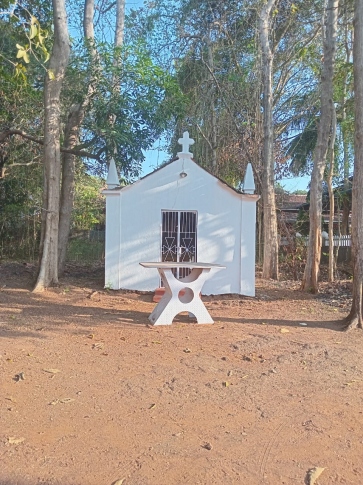
Frazer Andrade
In the month of May, the Holy Cross has been celebrated throughout the state with great pomp, thus becoming instrumental in fostering community building at the village level.

When one talks about the invention of the cross, it does not in any way speak about the creation of something that formerly did not exist. The origins of crucifixion by the cross dates back to the Assyrians and Babylonians. The Persians were known to use this method in the sixth century B.C. It was introduced to the Romans in the third century B.C. by the Phoenicians. Crucifixion was used as a tool for a painful and shameful execution for prisoners. For Christians, it is now a sign of glory and worship.

Invention in the sense used by the church comes from the Latin word inventio, meaning discovery or finding. During this feast, the church celebrates the finding of the true cross by St. Helena in 326 A.D. For centuries, the feast has been celebrated annually on May 03. Additions to the Roman calendar moved the Feast to May 07, a date significant in the Armenian calendar as the Apparition of the Holy Cross over Jerusalem in 451 A.D., as recorded by St. Cyril of Jerusalem. Pope John XXIII removed this feast in 1960, so that the General Roman Calendar now celebrates both the finding and the exaltation of the Holy Cross on September 14, although some Latin American countries and Mexico still celebrate the feast of the finding on May 03. Some communities which celebrate the liturgy in the extraordinary form of the Roman Rite also observe the feast of the finding of the Holy Cross on May 03.

The three-fold feast recalls three historical events: the finding of the True Cross by Saint Helena, the mother of the emperor Constantine; the dedication of churches built by Constantine on the site of the Holy Sepulchre and Mount Calvary; and the restoration of the True Cross to Jerusalem by the emperor Heraclius II. But in a deeper sense, the feast also celebrates the Holy Cross as the instrument of salvation. This instrument of torture, designed to degrade the worst of criminals, became the life-giving tree that reversed Adam's Original Sin when he ate from the Tree of the Knowledge of Good and Evil in the Garden of Eden.

In Goa, most villages have been dotted with roadside crosses and chapels dedicated to the Holy cross. These small road side crosses would have been built in fulfillment of a vow, in memory of the deceased or commemorating some noteworthy historical event. People from villages gather at these crosses singing praises in thanks giving through hinos de louvor/oraçãos and ladainha. These hymns, prayers and litanies would be traditionally sung only in Latin, Portuguese with sometimes a couple of hymns being sung in Konkani with a violin accompaniment. The violinist would be a local mestre who generally trained children to sing and/or play musical instruments. However unfortunately in today’s time Latin and Portuguese is being left to die off both by the church and church goers. The faithful in villages may have a nine-day novina followed by the feast or in some cases just the feast. A couple of places in Goa celebrating this feast on the May 03 are, Santa Cruz in Benaulim, the Holy cross chapel in Baradi and the Holy cross chapel in Ambajim. This year in Novo Vaddo, Sernabatim the Holy cross was celebrated on May 01.

In Santa Cruz, the feast of Holy Cross Church is celebrated on the Sunday between 2nd and 8th of May every year. While in Tintto, Calangute is celebrated on May 03 and at Caunsar-Porbavaddo on May 04Recognized all around Goa as Fulancho Khuris (Cross of Flowers) or the Miraculous Cross, the Holy Cross Shrine is a building in Bambolim which almost everyone crosses on the way to South Goa. Long before the Holy Cross church was built at this site, there was just a tiny white cross on the side of the road, having the charm of its own. The Shrine visible today, was built recently in 1996 forming a protective barrier around the Miraculous Cross which is now clad in white marble. Most people pay their respects here by offering candles, garlands of flowers or cash. The feast day of the Holy Cross Church, in Bambolim, is held annually on the third Sunday of May.
The Capella de Santa Cruz in Ambajim, in South Goa celebrates the Holy cross on May 03. The chapel came to be consecrated to the Holy Cross in 1930 when a crucifix made by the Chitari community of Cuncolim, South Goa was installed into the central niche of the polychrome stone retable in the Chapel.
Until around 1964, the villagers of Ambajim sang a Litany at the chapel during the nine-day novina followed by the feast. It was only post 1965 that mass began to be celebrated at the chapel on the day of the feast which was preceded by the traditional nine-day litany. As of date annually, just a mass is celebrated by a priest belonging to the Holy Spirit Church in Margão, outside the chapel at 6:00 pm, after which light refreshments are served. The practice of chanting the litany was discontinued in 1994. All utilities like sacred vessels, vestments needed for mass at the chapel have been borrowed for a day from the Calella do Sagrado Coração de Jesus in the same village. Deacon Jason Keith, from Goa mentions, ‘Red vestments have been worn on this day’. Red symbolizes the passion of Christ and the blood spilled in martyrdom by Him. A traditional Oração sung in Ambajim during the feast goes as ‘O bhagivonta Santa Curça, Somia Jezuchea polonga, ami somest Cristão nomoskar kortão tuka’.
